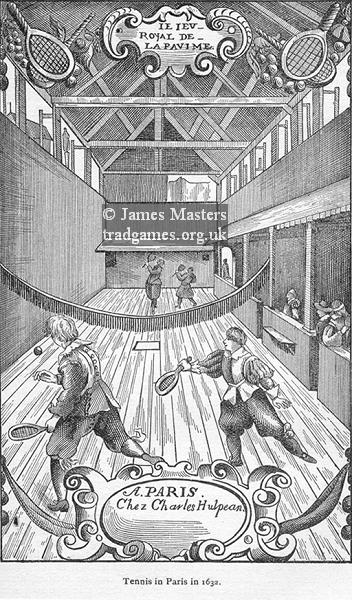
The origin of Tennis, like so many Sports and Games is something of a mystery with various theories having been espoused. One version would have us believe that Stone Age man once hit rocks backwards and forwards with clubs, perhaps. A more substantial beginning is that Tennis derived from Handball, a version of which was played in the ancient world including the civilisations of Rome, Greece and Egypt. There is an Egyptian town on the Nile called Tinnis (in Arabic) and some speculate that this is the origin of the name ‘Tennis’. Another string to this theory’s bow is that the term ‘racquet’ is thought to derive from the Arabic word ‘rahat’ which means ‘the palm of the hand’.
The first game which was definitely like Tennis was played in France and the alternative philological theory is that ‘Tennis’ comes from the French ‘Tenez’ (‘Take it’ or ‘Play’). Legend has it that the game was given to the French Royal Court in the 10th century by a wandering minstrel but, regardless, by the 11th century early Tennis was being played in French monasteries for sure. The monks usually stretched a rope across the cloistered central quadrangles in the monastery or sometimes played immediately adjacent to a castle and the court of the game of Royal Tennis is clearly synonymous with these beginnings. Hands were used to hit the ball to begin with (jeu de paume); gloves were used later on and eventually players started to use short bats. Louis IV and the Church both attempted to ban the game in France over the following years but this was clearly to no avail – there were supposedly around 1800 courts in France during the 13th century.
By the 14th century, Tennis had found its way to England where both Henry VII and Henry VIII apparently became keen players and instigated the building of courts up and down the country. Apparently Henry VIII invented the ‘service’ – his servants used to throw the ball up in the air for him because he was too fat to do it himself.
The Mysterious Tennis Scoring System
The picture to the left is from a book called Orbis Sensualism Pictus by Commenius, 1638.
And what of the sources of the words “love” and “deuce”. The latter is derived from the French “a deux du jeu” – two points away from game, or de unx , the English having shortened it first to “a deus” (“deus” being deux in old French) and thence thoroughly incorrectly to “deuce”. The similar proposal, that “love” comes from the French for egg – “l’oeuf”, is doubtful, despite the assumed linkage with the cricketing phrase “out for a duck’s egg (duck for short)”. The most likely explanation is that it comes from
The Decline of Tennis
The Tennis racket by 1500 was no longer completely made of wood but consisted of a wooden handle with a sheep gut strung head. The Royal enthusiasm for the game continued both in France during the sixteenth century where there were apparently more than 1000 courts in Paris alone at that time and in England during the Tudor seventeenth century. For unknown reasons, the game’s popularity waned in France and England during the 17th century and in France it was virtually non-existent by 1800. In England, the game continued but perhaps more as a fashionable pastime for the rich. Notable English royal players include George IV (1763-1830), Prince Albert (1819-1861) who owned a locker in the changing room at Hampton Court Palace which still bears his name, Edward VII (1842-1910) and George V (1866-1936).
Emergence of Lawn Tennis
Pictures of the 2 chaps and the picture to the left are from an American encyclopedia dated 1890. Already Lawn Tennis is described as “more common” than Real Tennis.
In 1874, a US traveller brought the game to the Americas and the US Lawn Tennis Association was formed in 1881. International competition soon followed, with the International Lawn Tennis Challenge Trophy (later the Davis Cup) first contested in 1900 and the Wightman Cup, for competition between British and American women’s teams, in 1923. Men’s singles and doubles play was included on the program for the first modern Olympic Games in 1896.
Survival of Real Tennis
The old game of Tennis (still called Jeu de Paume or ‘hand ball’ in France) in the meantime suffered a large eclipse as a result of the new found dominance of the Lawn version. The number of courts steadily diminished during the 20th century but at the turn of the century they are increasing again. I was informed that in 2001, the number of courts in use are 26 in Great Britain, 8 in the USA, 3 in France and 6 in Australia and the number of players is a few thousand around the world. Tennis is now called called Real Tennis or Royal Tennis in Britain to distinguish it from Lawn Tennis and in the USA it is known as Court Tennis. No two Royal Tennis courts are exactly alike. There are minor differences in the width or angle of the penthouse roof above the corridor and in the width of the tambour as well as the dimensions of the court. For instance, the court at Hampton Court is slightly wider than most.